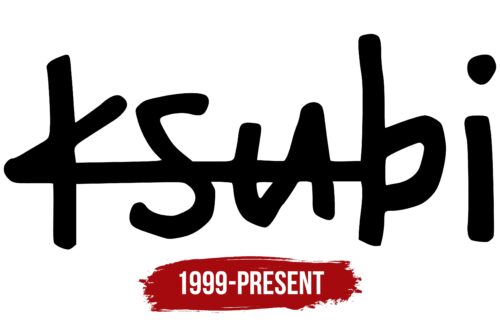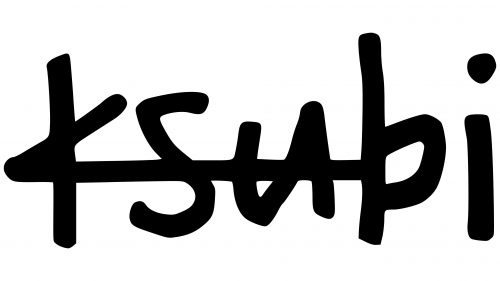The Ksubi logo can be called stylish and original—it is memorable and stays in your mind for a long time. This might be why this identity has accompanied the brand from its creation to today. However, other reasons contributed to its longevity. It should be remembered that the brand of original denim clothing emerged due to the dissatisfaction of four entrepreneurs with the quality of existing denim products. According to the founders’ idea, their company was meant to revolutionize the industry, and the products, thanks to all their efforts, were to become the benchmark of quality.
The founders reached their goal but with some reservations. The first significant change concerned the name: in 2002, the brand changed its name from “Tsubi” to “Ksubi,” and the letter “T” disappeared forever. The second important factor was the rapid development of the company. In light of all these changes, it became clear that the new brand identity could not be simple and ordinary. This is why the Ksubi emblem gained a distinct personality, infused with themes of originality and creativity, making it unique and distinctive from competitors.
Ksubi: Brand overview
The Ksubi story began in 1999 in Sydney, Australia. A group of friends, all surfers—Dan Single, Oscar Wright, George Gorrow, Paul Wilson, and Gareth Moody—founded the brand. Originally named “Tsubi,” the name was chosen randomly and had no particular meaning.
The founders started by making jeans for themselves and their friends. These original jeans gained popularity in Sydney’s surf scene due to their distinctive faded look and unique cut.
A turning point for the brand came in 2001 when it debuted at Australian Fashion Week. The Tsubi show caught the fashion world’s attention due to its unconventional approach. Instead of a typical runway show, the founders released 200 live rats onto the runway, shocking and delighting the audience. This bold move quickly made the brand a name in the fashion industry.
Following this successful launch, the company began to grow rapidly. After opening its first store in Sydney, the brand expanded its product line to include t-shirts, jackets, and accessories, combining its jeans with a broader collection. Its unique style, blending surf culture, punk, and high fashion elements, gained a dedicated following.
2003, the company entered the global market, selling in the U.S. and Europe. The brand was soon recognized by celebrities and fashion insiders, fueling further growth.
However, the business faced a significant challenge in 2006. Tsubo, an American shoe manufacturer, filed a trademark infringement lawsuit against the company. As a result, the brand was forced to change its name to “Ksubi.” Despite this setback, the company retained its reputation and customer base.
After the rebranding, the company continued to evolve. In 2008, it launched a collection of sunglasses, which quickly became popular, aligning with the “cool Aussie surfer” image the brand projected.
In 2009, the company opened its flagship store in New York City, solidifying its presence in the U.S. market. That same year, the brand began collaborating with musicians and artists, forging partnerships that further enhanced its cult status.
Despite this success, the company faced financial difficulties in 2010. Rapid growth and the global financial crisis led to liquidity problems, forcing the business into voluntary administration, the Australian equivalent of bankruptcy.
In 2011, Australian clothing retailer Bleach Group purchased the brand, stabilizing its financial position and enabling further expansion.
A new chapter began in 2013 when General Pants Co., a major Australian retailer, acquired the company. This acquisition gave the brand access to a wider distribution network and more resources for growth.
In 2014, the brand celebrated its 15th anniversary with a special collection that honored its origins and iconic designs while showcasing the company’s evolution.
After a long absence, the brand returned to the Australian Fashion Week runways in 2015. The fashion industry welcomed the comeback, viewing it as a sign that the company had retained its relevance and creative energy.
In 2017, the company released its first full women’s collection, updating its signature look for women’s fashion while keeping its distinct style.
The business continued its global expansion in 2018, strengthening its presence in key markets such as the U.S., UK, and Japan. The company collaborated with musician Travis Scott that year, creating a popular capsule collection.
In 2019, the brand released a limited-edition collection celebrating its 20th anniversary. Drawing inspiration from its archives, the collection demonstrated how the company had maintained its unique style while remaining relevant for two decades.
In 2020 and 2021, the brand focused on innovation and adaptation. The company strengthened its online presence through digital marketing and e-commerce efforts.
The business continued its collaborative approach in 2022, partnering with various brands and artists. These collaborations helped attract new customers and maintain its status as a fashion icon.
By 2023, the brand had become a well-known international streetwear name, recognized for its distinctive style and marketing approach. The company continued to explore new categories and designs while building on its core items, such as jackets and jeans.
Throughout its journey, the company has grown from a small Australian brand founded by surfer friends to a global streetwear business. Despite financial struggles and changes in ownership, the brand has preserved its unique identity and legendary status in the fashion world.
Meaning and History
What is Ksubi?
This Australian designer label gained popularity in denim and streetwear due to its edgy, anti-establishment stance. The brand combines high fashion with punk rock aesthetics, focusing on faded denim, often adorned with rips, tears, and unconventional washes. This style has become a staple for both celebrities and fashion-conscious individuals. In addition to jeans, the brand’s collections include a variety of clothing and accessories, all infused with a rebellious spirit. Their designs challenge fashion expectations, using bold graphics, unconventional cuts, and details that defy traditional fashion norms, emphasizing their anti-status philosophy.
1999 – today
The first and only Ksubi logo is significantly different from the standards. The letters in it resemble artistic elements rather than orthographic symbols. Each letter is unique in shape and size, giving the logo a special visual variety. The original font creates the impression that it was handwritten rather than printed, further emphasizing the brand’s individuality. The uneven width and height of the letters add expressiveness to the word as a whole and make it more memorable.
Special attention is drawn to the first letter, which combines elements of “K” and “T.” This is likely not done by chance, as the company places great importance on its traditions. This single letter serves as a reference to the brand’s past and a reminder of its original name, preserving a connection to its history.
The dark letters on a light background catch the eye, but so does the horizontal line that crosses four of the six letters—it symbolizes stability. The bold font creates a sense of depth and layers in each symbol, while the smooth, rounded edges contribute to easy perception and enhance the readability of the word.
The centered placement of the brand name in the logo is a classic technique in the identity design of past years, which has not lost its relevance. This suggests that the logo remains attractive and modern. Like the Australian fashion brand’s products, it continues to surprise with its originality.





